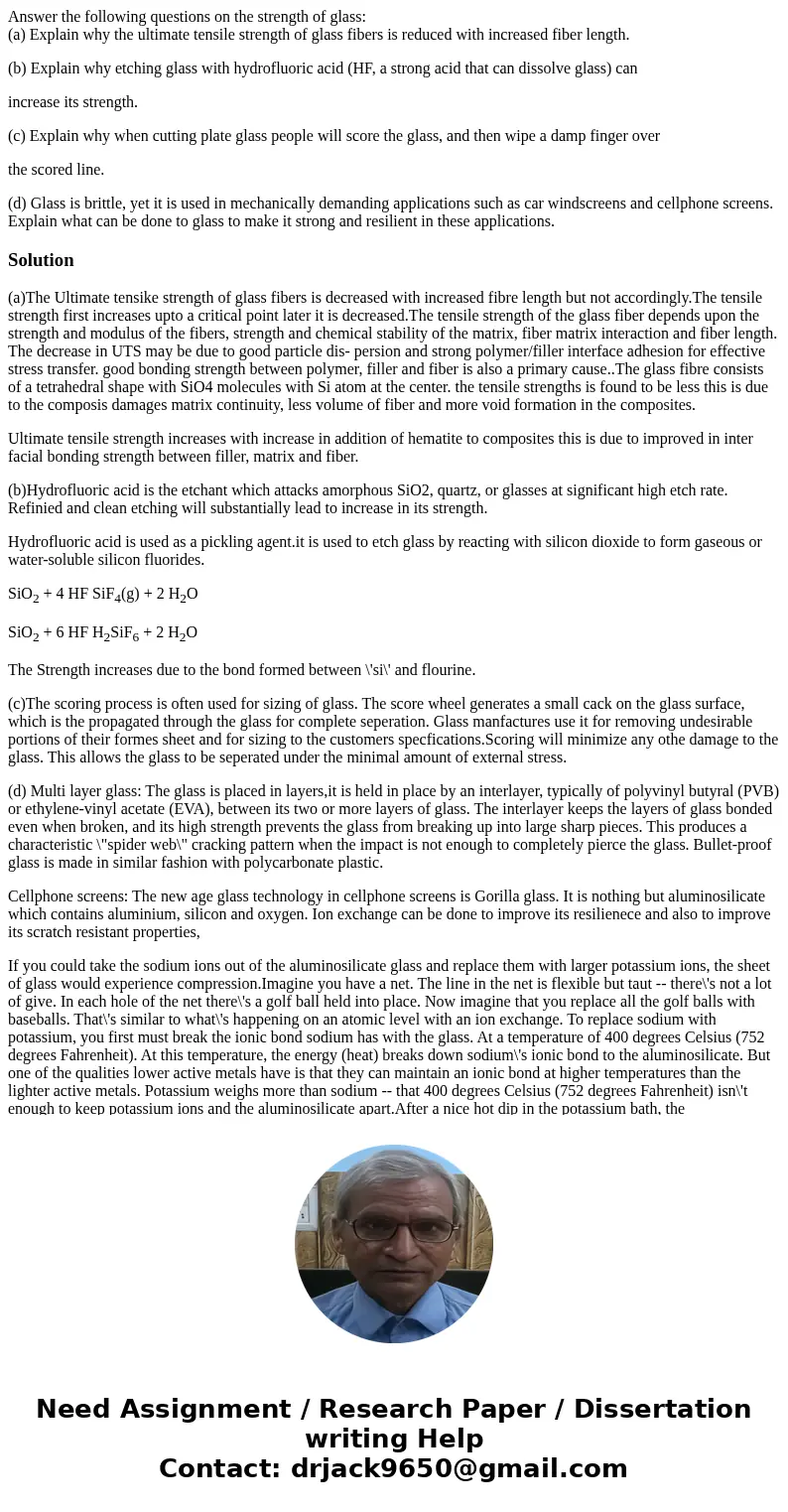Answer the following questions on the strength of glass a Ex
Answer the following questions on the strength of glass:
(a) Explain why the ultimate tensile strength of glass fibers is reduced with increased fiber length.
(b) Explain why etching glass with hydrofluoric acid (HF, a strong acid that can dissolve glass) can
increase its strength.
(c) Explain why when cutting plate glass people will score the glass, and then wipe a damp finger over
the scored line.
(d) Glass is brittle, yet it is used in mechanically demanding applications such as car windscreens and cellphone screens. Explain what can be done to glass to make it strong and resilient in these applications.
Solution
(a)The Ultimate tensike strength of glass fibers is decreased with increased fibre length but not accordingly.The tensile strength first increases upto a critical point later it is decreased.The tensile strength of the glass fiber depends upon the strength and modulus of the fibers, strength and chemical stability of the matrix, fiber matrix interaction and fiber length. The decrease in UTS may be due to good particle dis- persion and strong polymer/filler interface adhesion for effective stress transfer. good bonding strength between polymer, filler and fiber is also a primary cause..The glass fibre consists of a tetrahedral shape with SiO4 molecules with Si atom at the center. the tensile strengths is found to be less this is due to the composis damages matrix continuity, less volume of fiber and more void formation in the composites.
Ultimate tensile strength increases with increase in addition of hematite to composites this is due to improved in inter facial bonding strength between filler, matrix and fiber.
(b)Hydrofluoric acid is the etchant which attacks amorphous SiO2, quartz, or glasses at significant high etch rate. Refinied and clean etching will substantially lead to increase in its strength.
Hydrofluoric acid is used as a pickling agent.it is used to etch glass by reacting with silicon dioxide to form gaseous or water-soluble silicon fluorides.
SiO2 + 4 HF SiF4(g) + 2 H2O
SiO2 + 6 HF H2SiF6 + 2 H2O
The Strength increases due to the bond formed between \'si\' and flourine.
(c)The scoring process is often used for sizing of glass. The score wheel generates a small cack on the glass surface, which is the propagated through the glass for complete seperation. Glass manfactures use it for removing undesirable portions of their formes sheet and for sizing to the customers specfications.Scoring will minimize any othe damage to the glass. This allows the glass to be seperated under the minimal amount of external stress.
(d) Multi layer glass: The glass is placed in layers,it is held in place by an interlayer, typically of polyvinyl butyral (PVB) or ethylene-vinyl acetate (EVA), between its two or more layers of glass. The interlayer keeps the layers of glass bonded even when broken, and its high strength prevents the glass from breaking up into large sharp pieces. This produces a characteristic \"spider web\" cracking pattern when the impact is not enough to completely pierce the glass. Bullet-proof glass is made in similar fashion with polycarbonate plastic.
Cellphone screens: The new age glass technology in cellphone screens is Gorilla glass. It is nothing but aluminosilicate which contains aluminium, silicon and oxygen. Ion exchange can be done to improve its resilienece and also to improve its scratch resistant properties,
If you could take the sodium ions out of the aluminosilicate glass and replace them with larger potassium ions, the sheet of glass would experience compression.Imagine you have a net. The line in the net is flexible but taut -- there\'s not a lot of give. In each hole of the net there\'s a golf ball held into place. Now imagine that you replace all the golf balls with baseballs. That\'s similar to what\'s happening on an atomic level with an ion exchange. To replace sodium with potassium, you first must break the ionic bond sodium has with the glass. At a temperature of 400 degrees Celsius (752 degrees Fahrenheit). At this temperature, the energy (heat) breaks down sodium\'s ionic bond to the aluminosilicate. But one of the qualities lower active metals have is that they can maintain an ionic bond at higher temperatures than the lighter active metals. Potassium weighs more than sodium -- that 400 degrees Celsius (752 degrees Fahrenheit) isn\'t enough to keep potassium ions and the aluminosilicate apart.After a nice hot dip in the potassium bath, the aluminosilicate emerges compressed by potassium ions. The compression creates a protective layer on the glass and gives it strength that normal glass doesn\'t have.

 Homework Sourse
Homework Sourse